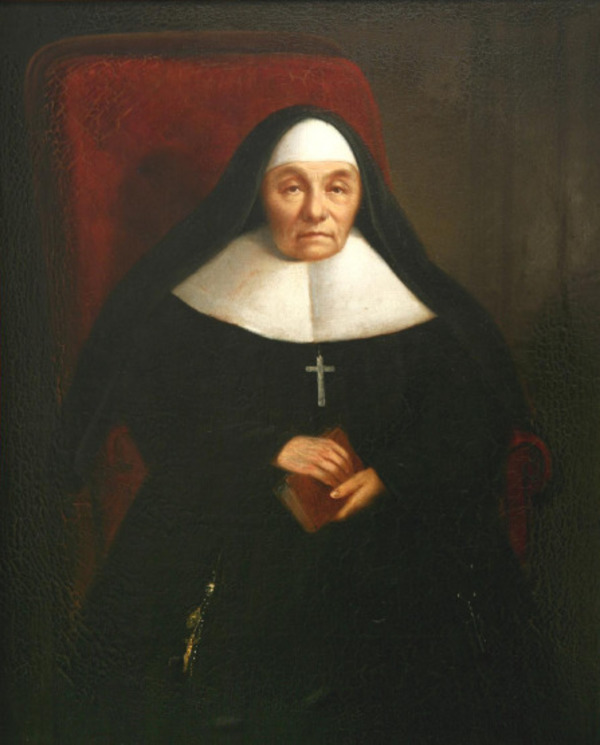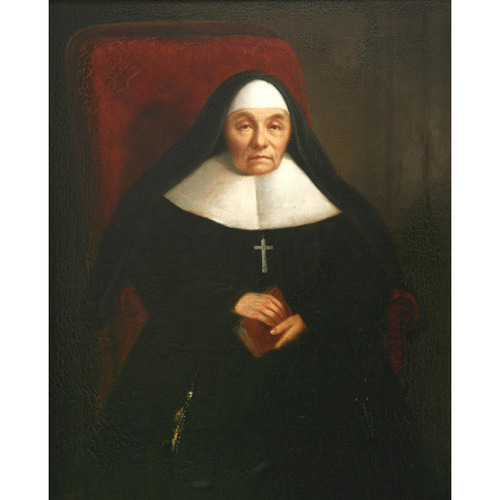
Source: Link
CADRON, MARIE-ROSALIE, dite de la Nativité (Jetté), founder of the Institut des Sœurs de Miséricorde (Institute of the Sisters of Mercy); b. 27 Jan. 1794 at Lavaltrie, Lower Canada, daughter of Antoine Cadron, dit Saint-Pierre, farmer, and of Rosalie Roy, dit Desjardins; d. 5 April 1864 at Montreal.
For 50 years Rosalie Cadron led a life similar to that of most women of her time. On 7 Oct. 1811, at age 17, she married Jean-Marie Jetté, and 11 children were born of this marriage; she became a widow on 14 June 1832. But in 1845, after 13 years of widowhood, and freed of her family responsibilities, her life took a new direction that was to have lasting significance for the social and religious history of Montreal.
For five years, in the privacy of her home, the widow Jetté had been looking after a number of unwed mothers, with a broadmindedness rare for that period and a real sense of human values. At the same time, Bishop Ignace Bourget* was convinced that, with Montreal fast becoming a large city, it was essential to help unwed mothers, rejected by their families and held in contempt by society. The bishop also thought that the church should create new religious communities, free of traditions or previous hampering ties, to meet new needs of society. The widow Jetté therefore seemed to him to be destined to carry forward and lend stability to his charitable activity for unwed mothers by founding a community devoted “to works of temporal and spiritual mercy.”
On 1 May 1845, despite the opposition of her children, who anticipated that Montreal society would disapprove, Rosalie Jetté went to live with a “penitent” in the faubourg Saint-Laurent, on Rue Saint-Simon, in a small house given for the new work by Antoine-Olivier Berthelet*, a rich citizen of Montreal and a regular benefactor of Bishop Bourget’s charities. The nascent community reached the decisive stage of its foundation on 16 Jan. 1848, when its founder and her female collaborators made their religious profession. Once she had become Sister Marie of the Nativity the widow Jetté refused any position of authority in her community, since she deemed herself incapable of properly directing the organization during the period of development that lay ahead. However, working in the background, she had a share in all the activities of the institute, including the reception of penitents, the care of new-born children at the “maternity room,” attendance on the sick in their own homes until 1862, and visits to prisons.
In 1851, after living in the home on Rue Saint-Simon, and in the more spacious but still shabby houses on Rue Wolfe and Rue Sainte-Catherine, she had the satisfaction of seeing the community permanently settled in a mother house on Rue Campeau. In particular, in the succeeding years, she was glad to find the public shaking off its Pharisaical aversion to unwed mothers and increasingly recognizing the usefulness of her community. Finally, in 1859, she welcomed the founding of the secondary order of the Madeleines as the unhoped-for complement to her endeavours; the sisters of this order, recruited from among the penitents, were allowed to take religious vows and lived within the community, obeying particular rules of dedication to contemplation.
When after five years of illness and isolation Sister Marie of the Nativity passed away in 1864, the community whose spirit she had shaped had proved its worth. It was then composed of 33 professed religious, 11 novices and postulants, 25 Madeleines and other women attached to the institute. The community had given asylum to 2,300 unwed mothers, as well as relieving other misfortunes when the occasion arose.
The widow Jetté’s charity had triumphed over the prejudices of her day. To a large extent she had succeeded in solving a delicate social problem, and the Hôpital de la Miséricorde, which played an essential role in the history of Montreal, stood as a witness to this until 1973.
Archives de l’Institut des Sœurs de Miséricorde (Cartierville, Qué.), Mémoire sur l’origine et les progrès de l’établissement de Sainte-Pélagie à Montréal jusqu’en 1867. Mélanges religieux, 1848–52. É.-J. [-A.] Auclair, Histoire des Sœurs de Miséricorde de Montréal; les premiers soixante-quinze ans de 1848 à 1923 (Montréal, 1928). P.-H. Barabé, “Mère de la Nativité, sa miséricorde,” Autour de Mgr Bourget: centenaires (Ottawa et Hull, Qué., 1942), 73–89. P.-A. Fournet, Marie de la Nativité et les origines des Sœurs de Miséricorde, 1848–1898 (Montréal, 1898). Pia Roseau [Rita Piuze-Balthazar], Grand-mère Rosalie; vie de Mère de la Nativité, fondatrice des Sœurs de Miséricorde (Montréal, 1964). “La chapelle de l’Institut de la Miséricorde,” La Semaine religieuse de Montréal, XIII (1889), 209–10. “Couvent de la Miséricorde; vêture et profession religieuse,” La Semaine religieuse de Montréal, LXXXVIII (1929), 510–11. “La crèche; chez les Sœurs de Miséricorde,” La Semaine religieuse de Montréal, XLVIII (1906), 357–60. “Nouvelle mission des Sœurs de Miséricorde à Green Bay, état du Wisconsin,” La Semaine religieuse de Montréal, XXXVI (1900), 243–45. “L’œuvre de la crèche des Sœurs de Miséricorde,” La Semaine religieuse de Montréal, XLII (1903), 335–36. “Profession religieuse chez les Sœurs de Miséricorde,” La Semaine religieuse de Montréal, XLI (1903), 207–8. “Les Sœurs de la Miséricorde,” La Semaine religieuse de Montréal, II (1883), 43–45. “Les Sœurs de Miséricorde à Montréal–Ottawa–New York–Winnipeg–Edmonton–Green Bay,” La Semaine religieuse de Montréal, XXXVII (1901), 13–14. “Sœurs de Miséricorde; vêture et profession,” La Semaine religieuse de Montréal, XCIII (1934), 76–77. “Sœurs de Miséricorde; vêture et profession religieuse,” La Semaine religieuse de Montréal, LXVI (1915), 152.
Cite This Article
Andrée Désilets, “CADRON, MARIE-ROSALIE, dite de la Nativité (Jetté),” in Dictionary of Canadian Biography, vol. 9, University of Toronto/Université Laval, 2003–, accessed April 1, 2025, https://www.biographi.ca/en/bio/cadron_marie_rosalie_9E.html.
The citation above shows the format for footnotes and endnotes according to the Chicago manual of style (16th edition). Information to be used in other citation formats:
| Permalink: | https://www.biographi.ca/en/bio/cadron_marie_rosalie_9E.html |
| Author of Article: | Andrée Désilets |
| Title of Article: | CADRON, MARIE-ROSALIE, dite de la Nativité (Jetté) |
| Publication Name: | Dictionary of Canadian Biography, vol. 9 |
| Publisher: | University of Toronto/Université Laval |
| Year of revision: | 1976 |
| Access Date: | April 1, 2025 |



